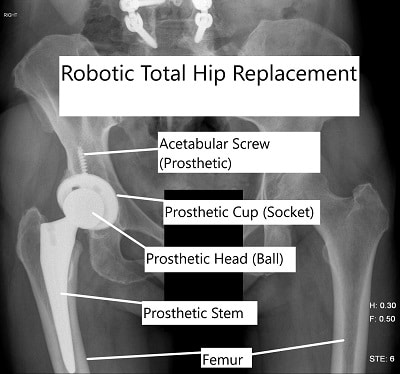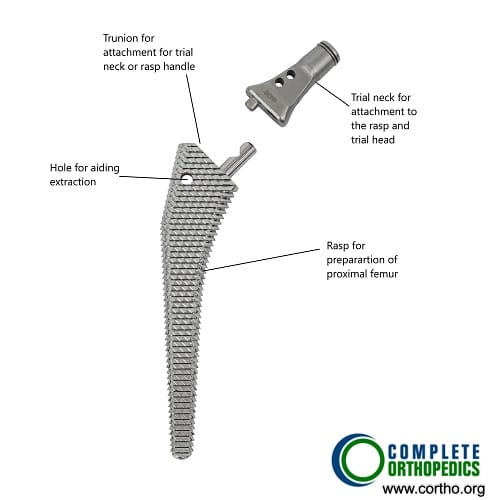Makoplasty Anterior Hip Replacement
Makoplasty anterior hip replacement is a surgery to replace the diseased parts of the Hip joint with prosthetic parts. The aim is to duplicate the function and balance the muscular forces acting around the joint.
Traditionally, the surgery has been performed from behind known as the posterior approach or from the side known as the lateral approach.
The more recent approach from the front, known as the anterior approach, promises a faster recovery with a decreased hospital stay.
The surgical technique, however, requires accurate placement and positioning of the implant. MAKOplasty is a unique robotic assistance system powered by RIO (Robotic Arm Interactive Orthopedic System), providing real time information. This helps in achieving precision in anterior Hip replacement.
Hip pain or stiffness may be caused by conditions such as osteoarthritis, post-traumatic arthritis, inflammatory arthritis, or hip dysplasia. Hip pain which is not relieved by conservative management can benefit from Hip replacement surgery.
The surgery involves access to the Hip joint and removal of diseased/arthritic bone. A prosthetic acetabular cup is placed in the pelvis socket with a specialized plastic over it to reduce friction. The upper part of the thigh is replaced with a prosthetic stem. A prosthetic head is placed over the stem.

X-ray showing robotic total hip replacement
Considerations for a successful surgery
Patient needs, skill, and expertise of the operating surgeon are important factors for successful outcomes of any surgery. Hip replacement surgery techniques such as MAKOplasty offer additional benefits for accurate implant placement. Accurate placement leads to an excellent outcome and an expedited recovery.
Placement and alignment of Components
The biomechanics of the Hip joint warrant accurate positioning of the implant for the prosthetic joint to duplicate both mobility and stability of the natural joint. Every patient has slightly different anatomy of the hip joint requiring a different positioning of the complements. Inaccurate placement leads to impingement, dislocation, reduced lifespan of implant, leg length discrepancies, or failure.
Bone preservation
Hip joint replacement requires the removal of diseased bone to make a place for the prosthetic implant. Removal of more than required bone leads to loss of bone stock for subsequent surgery and reduced stability for components.
Approach
The anterior approach to the Hip joint involves an incision in front of the Hip joint. The approach allows for muscles and tendons to be separated instead of cutting, as in the case of traditional approaches. The patients also enjoy expedited recovery and return to activities they enjoy. They enjoy early weight-bearing with fewer hip precautions like lying on back with a pillow in between the legs.

Rasp for preparing the femoral canal during hip replacement surgery
The images shows an instrument used in hip replacement surgery. The rasp has grooved surface to prepare the femoral canal to receive the prosthetic implant. The upper part has an attachment for handle to serially prepare the canal. once the final rasp is inserted for preparation, a trail head may be attached to the rasp to look for stability of the prosthetic implant.
MAKOplasty System
CT scan of the patient’s hip is taken several weeks before the surgery which is uploaded to the MAKO system. The CT scan images are then used to generate 3D models of the hip of the patient. This the accurate anatomy of the patient’s hip to help guide the surgeon.
The 3 D models are used to create a customized surgical plan. Each plan is individualized according to the patient’s anatomy. During the surgery, the surgeon uses the MAKO powered Robotic Arm Interactive Orthopaedic System to generate anatomical guidelines in the patient’s hip. The System then guides the surgeon for accurate placement of the implant position removing only the diseased bone.
The robotic arm does not perform the surgery or make independent decisions. The surgeon uses the robotic arms guidance making decisions. The surgeon remains in control of the system for every decision being made and can modify the system’s guidelines intraoperatively.
Benefits
Compared to traditional surgical techniques, Anterior Hip replacement assisted work MAKO System offers several benefits:
- Precise alignment and placement of the implant components based on patient-specific anatomy.
- Removal of only diseased bone and preservation of bone stock.
- Reduced blood loss during the surgery.
- Duplication of the biomechanics of the hip joint leading to the feeling of a natural hip.
- Decreased rate of complications such as hip dislocation or leg length discrepancy.
Complications
As with any hip replacement, there are potential complications that are discussed by the operating surgeon. There can be complications such as blood clots in the legs, pulmonary embolism, leg length discrepancy, dislocation, bone fracture, pain, infection, and nerve/vascular damage.
Summary
MAKOplasty anterior Hip replacement is an excellent option for relief of hip pain when indicated. Precise placement of components with a personalized surgical plan ensures the best outcomes of surgery and an expedited recovery.
Patients return to their previous activities sooner with a pain-free and natural feeling hip joint. Robotic innovations in other endeavors outside the operating room (OR) are making giant leaps. MAKOplasty System in OR offers precise surgical techniques that can be duplicated in every surgery.
Do you have more questions?
How does the recovery time for MakoPlasty compare to other minimally invasive hip replacement techniques?
Recovery time for MakoPlasty is often shorter compared to traditional hip replacement surgeries due to its minimally invasive nature and precision.
Are there any specific age limitations for patients undergoing MakoPlasty Anterior Hip Replacement?
Age alone isn’t a determining factor. The candidacy depends more on overall health and bone quality.
What are the potential complications associated with the robotic components used in MakoPlasty surgery?
Potential complications are minimal and may include injury to surrounding structures, although such occurrences are rare due to the precision of the robotic system.
Can MakoPlasty technology be used to correct leg length inequality after hip replacement surgery?
Yes, MakoPlasty can address leg length discrepancies by precisely adjusting implant placement during surgery.
Are there any specific exercises or rehabilitation protocols recommended after MakoPlasty surgery?
Yes, rehabilitation typically involves physical therapy exercises to improve strength, flexibility, and mobility, tailored to each patient’s needs.
How long does the MakoPlasty procedure typically take from start to finish?
The duration varies but generally takes around 1-2 hours, depending on factors such as patient anatomy and complexity of the case.
What factors determine whether a patient is a good candidate for MakoPlasty versus traditional hip replacement?
Factors include age, bone quality, overall health, and surgeon preference. MakoPlasty is particularly beneficial for patients with complex anatomies or those seeking a more precise outcome.
Are there any dietary restrictions or nutritional recommendations before and after MakoPlasty surgery?
Generally, no specific dietary restrictions are necessary, but maintaining a balanced diet rich in nutrients can aid in recovery.
Can MakoPlasty Anterior Hip Replacement be performed on patients with a history of prior hip surgeries?
Yes, MakoPlasty can be performed on patients with a history of prior hip surgeries, although individual circumstances may vary.
How does the cost of MakoPlasty surgery compare to traditional hip replacement methods?
The cost may vary depending on factors such as hospital fees, surgeon fees, and insurance coverage. In some cases, MakoPlasty may be slightly more expensive due to the advanced technology involved. However, long-term benefits may outweigh the initial costs.
What is the long-term success rate of MakoPlasty Anterior Hip Replacement compared to traditional methods?
Long-term success rates are generally favorable for MakoPlasty, with many patients experiencing improved function and pain relief. However, individual outcomes may vary.
Can MakoPlasty technology be used for other types of joint replacement surgeries besides the hip?
Yes, MakoPlasty technology is also used for knee replacement surgeries, providing similar benefits of precision and minimal invasiveness.
What are the potential risks associated with anesthesia during MakoPlasty surgery?
Anesthesia risks are similar to those of any surgical procedure and may include reactions to medications, respiratory issues, or complications related to pre-existing medical conditions. However, these risks are typically low and managed by experienced anesthesia providers.
Is MakoPlasty suitable for patients with severe hip arthritis or advanced joint degeneration?
MakoPlasty may still be an option for some patients with advanced arthritis or joint degeneration, especially if they have complex anatomies that require precise implant placement.
How soon after MakoPlasty surgery can patients return to driving and other daily activities?
Patients typically resume driving and light daily activities within a few weeks to a month after surgery, depending on individual recovery progress and clearance from their surgeon.
Are there any restrictions on bending, twisting, or lifting heavy objects after MakoPlasty surgery?
Initially, patients are advised to avoid strenuous activities and heavy lifting to allow for proper healing. Specific restrictions may vary depending on individual circumstances and surgeon recommendations.
Can MakoPlasty surgery be performed on both hips simultaneously?
While it is possible to perform bilateral MakoPlasty surgeries, this approach may increase the complexity of recovery and rehabilitation and is typically reserved for select cases.
What measures are taken to ensure proper alignment and stability of the hip joint during MakoPlasty surgery?
The robotic arm system used in MakoPlasty provides real-time feedback to the surgeon, enabling precise adjustments to optimize implant placement and joint alignment.
Is there a risk of infection or implant-related complications after MakoPlasty surgery?
While all surgeries carry some risk of infection or implant-related issues, MakoPlasty’s minimally invasive approach and sterile techniques help minimize these risks.
How does MakoPlasty technology accommodate for variations in patient anatomy and hip joint structure?
MakoPlasty utilizes advanced imaging and 3D mapping techniques to create personalized surgical plans tailored to each patient’s unique anatomy, ensuring optimal outcomes.

Dr. Suhirad Khokhar
My name is Dr. Suhirad Khokhar, and am an orthopaedic surgeon. I completed my MBBS (Bachelor of Medicine & Bachelor of Surgery) at Govt. Medical College, Patiala, India.
I specialize in musculoskeletal disorders and their management, and have personally approved of and written this content.
My profile page has all of my educational information, work experience, and all the pages on this site that I've contributed to.
